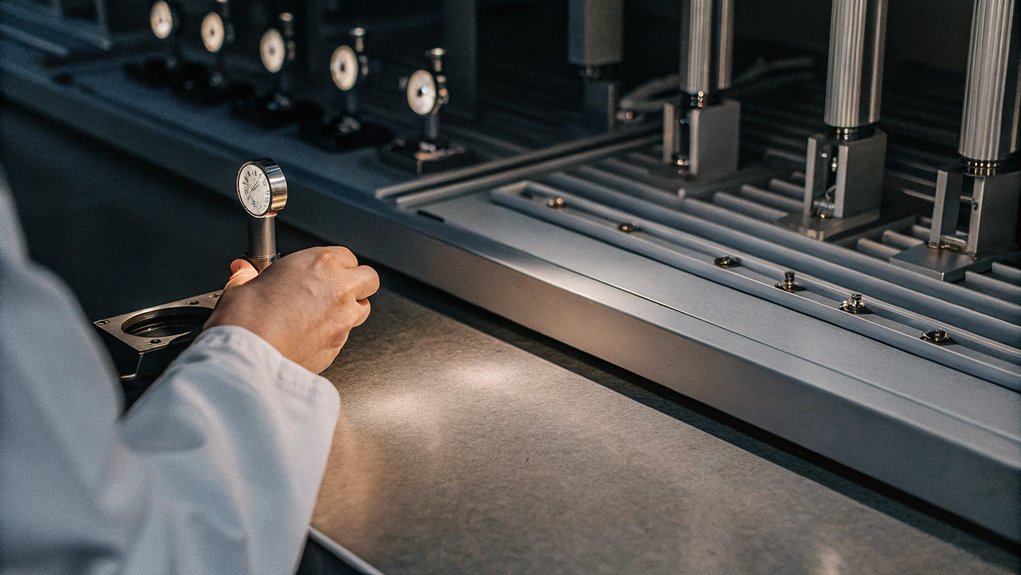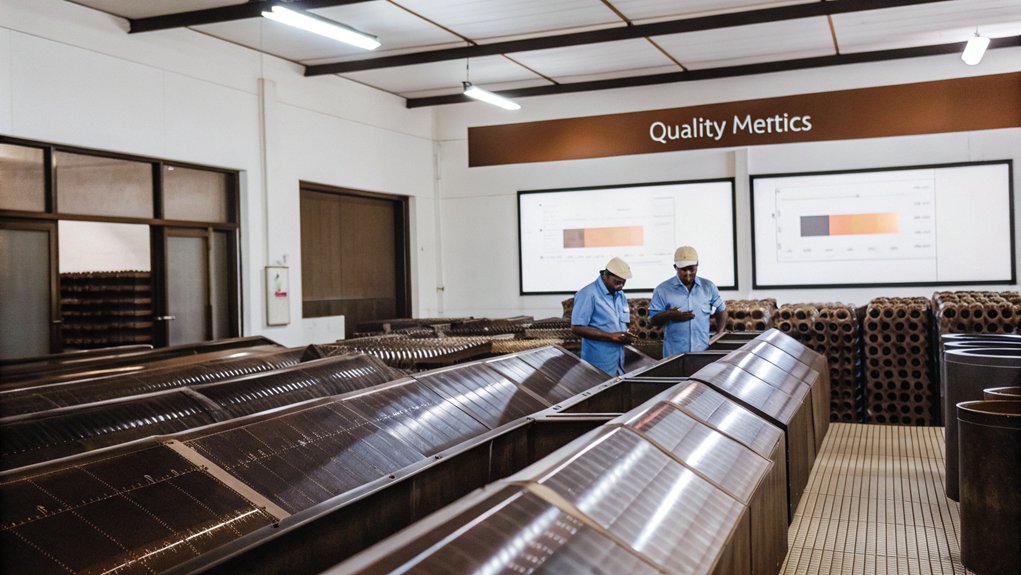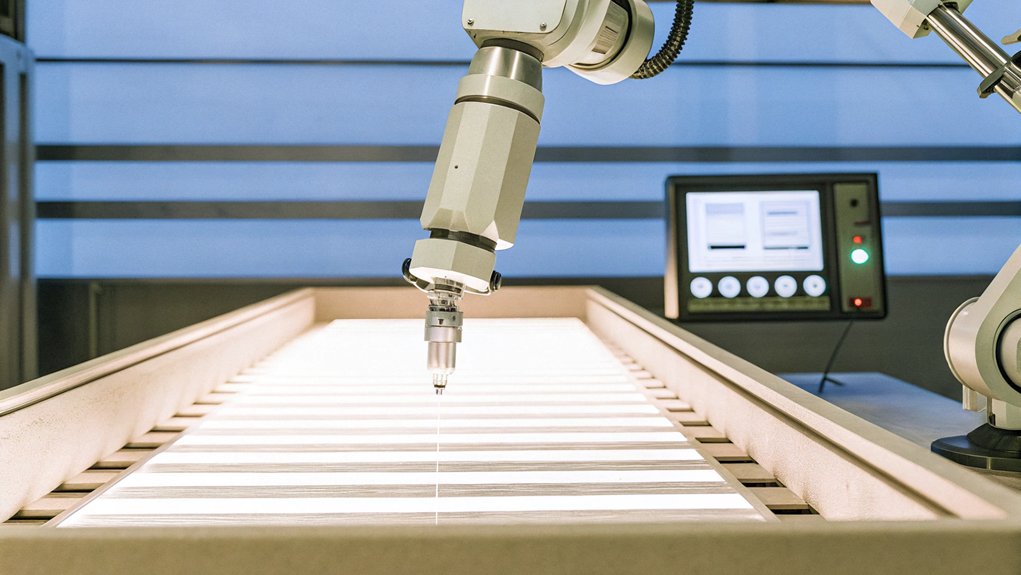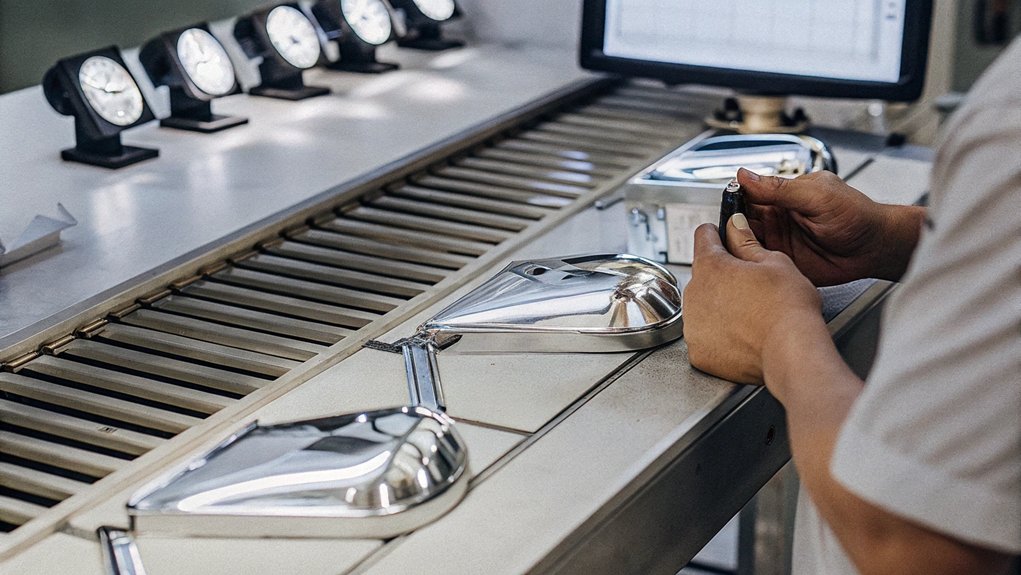In today’s competitive manufacturing landscape, understanding
quality assurance and testing is essential for maintaining product integrity. You need to recognize how these processes not only prevent defects but also enhance
operational efficiency. By examining the nuances of
quality management systems and their implementation, you can uncover the advantages they offer. What specific strategies truly drive success in quality assurance, and how can they be tailored to your unique production environment?
Key Takeaways
- Quality Assurance (QA) focuses on preventing defects through proactive measures and continuous improvement, while Quality Control (QC) inspects products to identify defects post-production.
- Implementing a robust Quality Management System (QMS) enhances operational efficiency, reduces waste, and ensures compliance with industry standards.
- Utilizing real-time data tracking and automation tools allows for immediate corrective actions and minimizes manual errors in the manufacturing process.
- Regular employee training on QA protocols and standardized operating procedures (SOPs) fosters a culture of quality and reduces defect rates significantly.
- Key Performance Indicators (KPIs) are essential for measuring QA effectiveness and identifying persistent issues for continuous improvement in manufacturing.
Understanding Quality Assurance in Manufacturing
Quality assurance in manufacturing embodies a commitment to excellence that transcends mere compliance with specifications. Understanding
quality assurance practices requires recognizing the significance of a robust Quality Management System (QMS).
This system defines processes, trains personnel, and guarantees compliance with industry standards, like
ISO 9000. By embedding a culture of
continuous improvement, you’ll reduce defect rates and enhance customer satisfaction.
Effective QA hinges on standard operating procedures (SOPs),
real-time monitoring, and
regular audits to pinpoint areas for enhancement. Emphasizing these elements not only minimizes defects but also optimizes resources and time.
Consequently, you can focus on innovation and personalized production, fostering a sense of belonging within your organization and among your customers.
The Role of Quality Control in Quality Assurance
While many may see quality control (QC) as a secondary aspect of quality assurance (QA), it plays a crucial role in the overall framework of manufacturing excellence. QC is a reactive process, focusing on inspecting and testing products to guarantee compliance with QA standards. By monitoring production processes and conducting inspections, QC identifies defects before they reach customers, safeguarding both quality and customer satisfaction.
| QC Activities | Purpose |
| Final Product Inspections | Verify that products meet quality standards |
| In-Process Checks | Detect defects during production |
| Monitoring Production | Guarantee adherence to QA protocols |
| Compliance Verification | Meet industry regulations |
Together, QA and QC form a Quality Management System (QMS) that guarantees consistent product quality throughout the manufacturing process.
Benefits of Implementing Quality Assurance
Implementing
Quality Assurance in your manufacturing process can lead to substantial
cost savings by markedly reducing defect rates and minimizing waste.
You’ll also enhance
operational efficiency, allowing for streamlined workflows that boost productivity.
Furthermore, adhering to QA standards guarantees compliance with regulations, mitigating risks associated with penalties and reputational damage.
Cost Savings and Efficiency
When organizations prioritize robust Quality Assurance (QA) processes, they often release significant
cost savings and efficiency gains. By reducing defects and minimizing waste, you could see up to a 20%
cost reduction in manufacturing operations.
A proactive QA approach typically boosts
operational efficiency by 30%, allowing you to reallocate resources to critical production areas. Additionally, adopting effective QA practices can lead to a 50% drop in
rework costs, thanks to early identification of quality issues.
Enhanced quality management not only streamlines processes but also quickens product delivery, giving you a competitive edge of up to 25%. Ultimately, these improvements in quality can elevate
customer satisfaction and loyalty, further driving your revenue and profitability.
Compliance and Risk Management
Establishing a thorough Quality Assurance (QA) system is essential for guaranteeing compliance with industry regulations and managing risks effectively. By implementing a robust QA framework, you can identify potential quality issues early, greatly reducing the impact on your operations and costs. This fosters a culture of accountability and minimizes defects, enhancing overall product quality.
| Benefit | Impact on Compliance | Impact on Risk Management |
| Early Issue Detection | Reduces legal issues | Minimizes production disruptions |
| Continuous Monitoring | Adapts to changing regulations | Mitigates financial risks |
| Defined Processes | Guarantees standardization | Promotes accountability |
| Reduced Defect Rates | Lowers warranty claims | Improves customer satisfaction |
Investing in QA practices can lead to a more compliant and resilient organization.
Key Components of a Quality Management System
To guarantee effective quality assurance practices, you need to understand the key components of a Quality Management System (QMS).
By establishing clear
quality policies and objectives, you can align your team’s efforts towards achieving consistent quality outcomes.
Additionally, integrating
continuous improvement strategies within your QMS will help you identify and address inefficiencies as they arise.
Essential QA Practices
In any effective Quality Management System (QMS), well-defined processes and standard operating procedures (SOPs) form the backbone that minimizes variability and guarantees consistent product quality.
Implementing
quality assurance best practices involves regular employee training to make certain your workforce understands and upholds QA protocols.
Integrating
quality control measures throughout the production process is vital for identifying defects early and maintaining compliance with quality requirements.
Establishing key performance indicators (KPIs) enables you to measure the effectiveness of your QA practices and pinpoint areas for improvement.
Furthermore, conducting regular
internal and external audits is necessary to assess the QMS’s effectiveness and make certain adherence to industry standards.
Together, these essential QA practices foster a culture of quality and continuous improvement within your organization.
Continuous Improvement Strategies
Building on the foundation of effective QA practices,
continuous improvement strategies are integral to a robust Quality Management System (QMS).
By embracing methodologies like
Lean and Six Sigma, you can systematically pinpoint inefficiencies, leading to significant process improvement.
Regular audits and assessments are essential; they help identify areas of non-conformance and highlight opportunities for enhancement within your QMS.
Involving employees in continuous improvement initiatives fosters a
culture of quality, empowering them to contribute valuable ideas. Additionally, implementing a feedback loop guarantees that data from quality control processes drives informed decision-making, aligning improvements with strategic objectives.
With these strategies in place, you’ll not only meet but consistently
exceed customer expectations, reinforcing your commitment to quality.
Best Practices for Quality Assurance in Manufacturing
Effective
quality assurance in manufacturing hinges on a few key best practices that can greatly elevate product consistency and reliability.
Start by implementing standardized operating procedures (SOPs) in line with ISO 9000 to minimize variability. Leverage
real-time data tracking, like MachineMetrics, to document quality issues instantly, allowing for immediate corrective actions.
Encourage regular
employee training on quality standards to foster a culture of continuous improvement and accountability. Establish strategic key performance indicators (KPIs) to measure the effectiveness of your quality management system (QMS), aligning team focus on quality objectives.
Finally, conduct
routine audits and assessments to guarantee compliance with industry regulations while identifying opportunities for process enhancements.
These practices form a solid foundation for effective quality assurance in your manufacturing processes.
The Importance of Training and Teamwork in QA
Quality assurance thrives not just on established practices but also on the knowledge and collaboration of your workforce. Effective training programs equip you and your team with the skills needed to understand and uphold quality standards. This proactive approach reduces defect rates by up to 30%.
| Benefit | Description |
| Enhanced Skills | Training sharpens your ability to identify issues. |
| Collaborative Culture | Teamwork encourages sharing insights and best practices. |
| Increased Engagement | Team-based initiatives foster ownership over quality. |
Tools and Technologies for Quality Assurance
As manufacturing processes evolve, leveraging
advanced tools and technologies becomes essential for ensuring consistent
quality assurance.
You’ll find that
integrated software platforms like ERP, MES, and quality management systems (QMS) streamline operations, eliminating data silos.
Automation tools, including robotic process automation (RPA) and AI-driven analytics, enhance quality control through
real-time monitoring and
predictive maintenance, reducing downtime and defects.
IoT sensors deliver real-time data on machine performance, allowing for immediate corrective actions that boost efficiency.
Cloud-based QMS standardizes processes and automates documentation, fostering collaboration across departments.
Ultimately,
visualization technologies like virtual and augmented reality enhance training and inspection experiences, deepening your understanding of quality standards.
Together, these tools and equipment create a cohesive framework for superior quality assurance.
Measuring Quality Assurance Success With KPIS
To effectively measure quality assurance success, you need to establish clear
Key Performance Indicators (KPIs) that align with your manufacturing goals.
Tracking process efficiency metrics allows you to assess areas for improvement, while analyzing
defect rate trends helps identify persistent issues.
Defining Key Performance Indicators
Defining Key Performance Indicators (KPIs) is essential for any
manufacturing process aiming to enhance
quality assurance. KPIs provide
measurable values that indicate how effectively you’re achieving your quality objectives.
Common KPIs, like
defect rates,
first-pass yield, and customer complaints, pinpoint areas for improvement. By setting SMART goals for these indicators, you guarantee your quality assurance efforts are focused and results-driven.
Regular review and analysis of KPI data enable you to track progress and make informed decisions. Aligning KPIs with organizational goals—such as reducing scrap rates or improving on-time delivery—fosters a culture of accountability and
continuous improvement.
This systematic approach empowers you and your team to drive quality enhancements, creating a more efficient and reliable manufacturing process.
Tracking Process Efficiency Metrics
When tracking process efficiency metrics, understanding the relationship between these metrics and your quality assurance goals is essential for driving improvements.
Key Performance Indicators (KPIs) like first-pass yield (FPY) and
defect rates provide critical insights into your production quality. FPY reflects the efficiency of your processes, while defect rates highlight areas needing improvement.
Monitoring
cycle time helps you identify bottlenecks, ensuring your operations run smoothly. Additionally, keeping an eye on
scrap rates allows you to optimize resource utilization, reducing waste and costs.
Customer complaints and returns serve as valuable feedback, guiding your continuous improvement efforts. By systematically analyzing these KPIs, you can foster a culture of quality and efficiency, enhancing overall manufacturing performance.
Analyzing Defect Rate Trends
Monitoring process efficiency metrics naturally leads to a focus on
defect rate trends, which serve as a powerful indicator of your
quality assurance success.
By analyzing the percentage of defective products over time, you gain invaluable insights into the effectiveness of your quality assurance processes.
Key Performance Indicators like Defect Rate and First Pass Yield allow you to measure success quantitatively.
A decreasing defect rate signifies effective quality assurance practices, enhancing
customer satisfaction while reducing rework costs. Utilizing tools like Pareto charts helps you pinpoint common defects, streamlining your
continuous improvement efforts.
Regularly tracking these trends empowers you to adapt strategies, fostering a culture of quality and collaboration within your organization. This commitment is essential for
long-term success.
Trends Shaping the Future of Quality Assurance
As the manufacturing landscape evolves, several key trends are reshaping quality assurance practices.
The integration of
Industry 4.0 technologies, including IoT and AI, empowers you with
real-time data analytics, enabling predictive maintenance and timely corrective actions.
Cloud-based Quality Management Systems (QMS) are increasingly accessible for SMEs, streamlining quality process management while reducing IT costs.
Additionally,
automation in quality assurance is minimizing manual errors and enhancing efficiency through advanced robotics and machine learning.
The adoption of
virtual and augmented reality tools is transforming training and inspection, fostering engagement and accuracy.
Finally,
continuous improvement methodologies like Lean and Six Sigma are gaining traction, promoting a culture of excellence and waste reduction in your manufacturing processes.
Real-World Examples of Quality Assurance in Action
Real-world applications of
quality assurance demonstrate how various industries effectively implement strategies to enhance product quality and operational efficiency.
For instance, a leading
automotive manufacturer adopted a quality management system (QMS) based on ISO 9000, achieving a 30% reduction in
defect rates.
Similarly, a high-tech electronics company used
real-time monitoring to document quality issues, cutting scrap rates by 25%.
In food processing, standardized operating procedures improved product consistency and reduced complaints by 40%.
A medical device manufacturer employed
predictive maintenance to identify issues early, resulting in a 50% decrease in recalls.
Finally, an
aerospace parts supplier analyzed scrap data with pareto charts, enhancing production efficiency by 20%.
These examples highlight the crucial role of manufacturing quality control in driving success.
Frequently Asked Questions
What Is the QA Process in Manufacturing?
The QA process in manufacturing focuses on quality control to guarantee products meet compliance standards.
You define
quality metrics, train your team, and implement standard operating procedures.
Regular audits help identify areas for
process improvement, allowing you to mitigate potential defects early.
What Are the 5 P’s of Quality Assurance?
The
5 P’s of quality assurance are essential for achieving effective quality control. First, you focus on the
Product, ensuring it meets specifications.
Then, emphasize
Process improvement to minimize variability and enhance efficiency.
Next, consider
People; skilled employees are critical for maintaining quality.
The Plant environment must support your goals, while Procedures lay down the framework for defect prevention.
Together, these elements create a robust system that fosters a culture of excellence and accountability.
What Is Quality Assurance Testing?
Quality assurance testing guarantees products meet quality standards through
systematic evaluation.
You’ll use various
testing methods, like functional and performance testing, to identify any defects.
Assurance techniques help you assess
product reliability and safety at each stage.
By implementing these strategies, you’ll not only enhance
operational efficiency but also foster trust among customers, guaranteeing that their expectations are consistently met.
This meticulous approach creates a sense of belonging to a quality-driven community.
What Is Quality Testing in Manufacturing?
Quality testing in manufacturing involves evaluating products against established quality metrics and testing standards.
You identify
defects through systematic methods like visual inspections and functional testing, ensuring that each item meets customer expectations.
By conducting
thorough defect analysis, you can pinpoint issues early, reducing the risk of failures later.
This methodical approach not only enhances
product reliability but also fosters a sense of trust and belonging among consumers who rely on consistent quality.
Conclusion
In the intricate dance of manufacturing,
quality assurance is the guiding conductor, ensuring each note harmonizes to create a flawless symphony. By embracing
robust QA practices, you not only prevent defects but also weave a tapestry of trust with your customers. As you navigate this landscape, remember that every
proactive measure enhances the melody of production, ultimately leading to a masterpiece of efficiency and satisfaction. Embrace the journey, and let quality be the rhythm that drives your success.
 While many may see quality control (QC) as a secondary aspect of quality assurance (QA), it plays a crucial role in the overall framework of manufacturing excellence. QC is a reactive process, focusing on inspecting and testing products to guarantee compliance with QA standards. By monitoring production processes and conducting inspections, QC identifies defects before they reach customers, safeguarding both quality and customer satisfaction.
While many may see quality control (QC) as a secondary aspect of quality assurance (QA), it plays a crucial role in the overall framework of manufacturing excellence. QC is a reactive process, focusing on inspecting and testing products to guarantee compliance with QA standards. By monitoring production processes and conducting inspections, QC identifies defects before they reach customers, safeguarding both quality and customer satisfaction.
 Implementing Quality Assurance in your manufacturing process can lead to substantial cost savings by markedly reducing defect rates and minimizing waste.
You’ll also enhance operational efficiency, allowing for streamlined workflows that boost productivity.
Furthermore, adhering to QA standards guarantees compliance with regulations, mitigating risks associated with penalties and reputational damage.
Implementing Quality Assurance in your manufacturing process can lead to substantial cost savings by markedly reducing defect rates and minimizing waste.
You’ll also enhance operational efficiency, allowing for streamlined workflows that boost productivity.
Furthermore, adhering to QA standards guarantees compliance with regulations, mitigating risks associated with penalties and reputational damage.
 To guarantee effective quality assurance practices, you need to understand the key components of a Quality Management System (QMS).
By establishing clear quality policies and objectives, you can align your team’s efforts towards achieving consistent quality outcomes.
Additionally, integrating continuous improvement strategies within your QMS will help you identify and address inefficiencies as they arise.
To guarantee effective quality assurance practices, you need to understand the key components of a Quality Management System (QMS).
By establishing clear quality policies and objectives, you can align your team’s efforts towards achieving consistent quality outcomes.
Additionally, integrating continuous improvement strategies within your QMS will help you identify and address inefficiencies as they arise.
 Effective quality assurance in manufacturing hinges on a few key best practices that can greatly elevate product consistency and reliability.
Start by implementing standardized operating procedures (SOPs) in line with ISO 9000 to minimize variability. Leverage real-time data tracking, like MachineMetrics, to document quality issues instantly, allowing for immediate corrective actions.
Encourage regular employee training on quality standards to foster a culture of continuous improvement and accountability. Establish strategic key performance indicators (KPIs) to measure the effectiveness of your quality management system (QMS), aligning team focus on quality objectives.
Finally, conduct routine audits and assessments to guarantee compliance with industry regulations while identifying opportunities for process enhancements.
These practices form a solid foundation for effective quality assurance in your manufacturing processes.
Effective quality assurance in manufacturing hinges on a few key best practices that can greatly elevate product consistency and reliability.
Start by implementing standardized operating procedures (SOPs) in line with ISO 9000 to minimize variability. Leverage real-time data tracking, like MachineMetrics, to document quality issues instantly, allowing for immediate corrective actions.
Encourage regular employee training on quality standards to foster a culture of continuous improvement and accountability. Establish strategic key performance indicators (KPIs) to measure the effectiveness of your quality management system (QMS), aligning team focus on quality objectives.
Finally, conduct routine audits and assessments to guarantee compliance with industry regulations while identifying opportunities for process enhancements.
These practices form a solid foundation for effective quality assurance in your manufacturing processes.
 Quality assurance thrives not just on established practices but also on the knowledge and collaboration of your workforce. Effective training programs equip you and your team with the skills needed to understand and uphold quality standards. This proactive approach reduces defect rates by up to 30%.
Quality assurance thrives not just on established practices but also on the knowledge and collaboration of your workforce. Effective training programs equip you and your team with the skills needed to understand and uphold quality standards. This proactive approach reduces defect rates by up to 30%.
 As manufacturing processes evolve, leveraging advanced tools and technologies becomes essential for ensuring consistent quality assurance.
You’ll find that integrated software platforms like ERP, MES, and quality management systems (QMS) streamline operations, eliminating data silos.
Automation tools, including robotic process automation (RPA) and AI-driven analytics, enhance quality control through real-time monitoring and predictive maintenance, reducing downtime and defects.
IoT sensors deliver real-time data on machine performance, allowing for immediate corrective actions that boost efficiency.
Cloud-based QMS standardizes processes and automates documentation, fostering collaboration across departments.
Ultimately, visualization technologies like virtual and augmented reality enhance training and inspection experiences, deepening your understanding of quality standards.
Together, these tools and equipment create a cohesive framework for superior quality assurance.
As manufacturing processes evolve, leveraging advanced tools and technologies becomes essential for ensuring consistent quality assurance.
You’ll find that integrated software platforms like ERP, MES, and quality management systems (QMS) streamline operations, eliminating data silos.
Automation tools, including robotic process automation (RPA) and AI-driven analytics, enhance quality control through real-time monitoring and predictive maintenance, reducing downtime and defects.
IoT sensors deliver real-time data on machine performance, allowing for immediate corrective actions that boost efficiency.
Cloud-based QMS standardizes processes and automates documentation, fostering collaboration across departments.
Ultimately, visualization technologies like virtual and augmented reality enhance training and inspection experiences, deepening your understanding of quality standards.
Together, these tools and equipment create a cohesive framework for superior quality assurance.
 To effectively measure quality assurance success, you need to establish clear Key Performance Indicators (KPIs) that align with your manufacturing goals.
Tracking process efficiency metrics allows you to assess areas for improvement, while analyzing defect rate trends helps identify persistent issues.
To effectively measure quality assurance success, you need to establish clear Key Performance Indicators (KPIs) that align with your manufacturing goals.
Tracking process efficiency metrics allows you to assess areas for improvement, while analyzing defect rate trends helps identify persistent issues.
 As the manufacturing landscape evolves, several key trends are reshaping quality assurance practices.
The integration of Industry 4.0 technologies, including IoT and AI, empowers you with real-time data analytics, enabling predictive maintenance and timely corrective actions.
Cloud-based Quality Management Systems (QMS) are increasingly accessible for SMEs, streamlining quality process management while reducing IT costs.
Additionally, automation in quality assurance is minimizing manual errors and enhancing efficiency through advanced robotics and machine learning.
The adoption of virtual and augmented reality tools is transforming training and inspection, fostering engagement and accuracy.
Finally, continuous improvement methodologies like Lean and Six Sigma are gaining traction, promoting a culture of excellence and waste reduction in your manufacturing processes.
As the manufacturing landscape evolves, several key trends are reshaping quality assurance practices.
The integration of Industry 4.0 technologies, including IoT and AI, empowers you with real-time data analytics, enabling predictive maintenance and timely corrective actions.
Cloud-based Quality Management Systems (QMS) are increasingly accessible for SMEs, streamlining quality process management while reducing IT costs.
Additionally, automation in quality assurance is minimizing manual errors and enhancing efficiency through advanced robotics and machine learning.
The adoption of virtual and augmented reality tools is transforming training and inspection, fostering engagement and accuracy.
Finally, continuous improvement methodologies like Lean and Six Sigma are gaining traction, promoting a culture of excellence and waste reduction in your manufacturing processes.
 Real-world applications of quality assurance demonstrate how various industries effectively implement strategies to enhance product quality and operational efficiency.
For instance, a leading automotive manufacturer adopted a quality management system (QMS) based on ISO 9000, achieving a 30% reduction in defect rates.
Similarly, a high-tech electronics company used real-time monitoring to document quality issues, cutting scrap rates by 25%.
In food processing, standardized operating procedures improved product consistency and reduced complaints by 40%.
A medical device manufacturer employed predictive maintenance to identify issues early, resulting in a 50% decrease in recalls.
Finally, an aerospace parts supplier analyzed scrap data with pareto charts, enhancing production efficiency by 20%.
These examples highlight the crucial role of manufacturing quality control in driving success.
Real-world applications of quality assurance demonstrate how various industries effectively implement strategies to enhance product quality and operational efficiency.
For instance, a leading automotive manufacturer adopted a quality management system (QMS) based on ISO 9000, achieving a 30% reduction in defect rates.
Similarly, a high-tech electronics company used real-time monitoring to document quality issues, cutting scrap rates by 25%.
In food processing, standardized operating procedures improved product consistency and reduced complaints by 40%.
A medical device manufacturer employed predictive maintenance to identify issues early, resulting in a 50% decrease in recalls.
Finally, an aerospace parts supplier analyzed scrap data with pareto charts, enhancing production efficiency by 20%.
These examples highlight the crucial role of manufacturing quality control in driving success.








